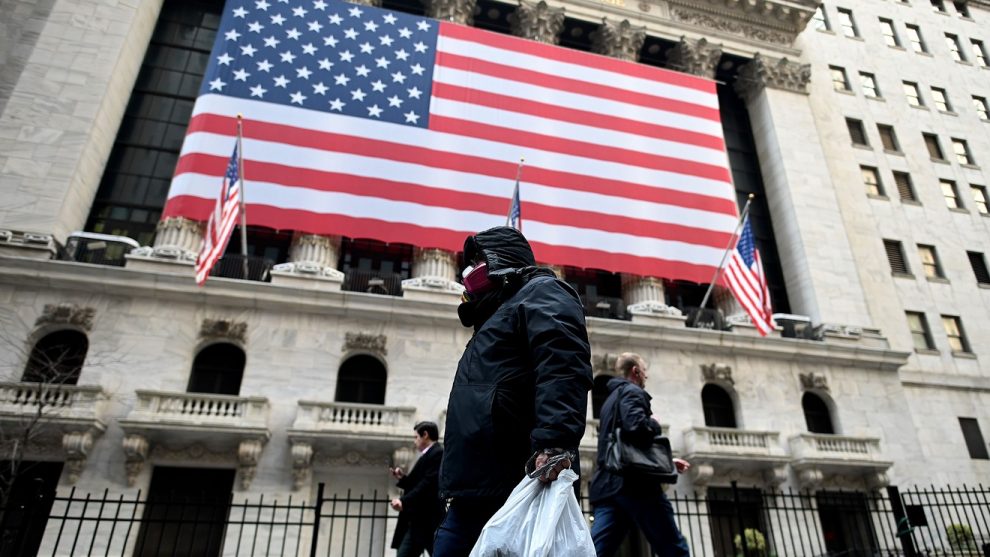
Main Street thinks Wall Street is crazy. Wall Street thinks Main Street is going to be relatively OK.
That’s the apparent message after the Dow Jones Industrial Average DJIA, +1.90% jumped more than 400 points Friday and stocks continued a torrid rebound despite data that showed the U.S. economy shed more than 20 million jobs in April. Lockdowns aimed at containing the deadly COVID-19 pandemic pushed the unemployment rate up to 14.7% — a postwar high that economists said likely understates the devastation.
Read: Great Depression 2020? The unofficial U.S. jobless rate is at least 20%—or worse
Advisors and analysts say they have been inundated with calls from clients asking why stocks keep soaring as the economic data grows uglier by the day.
They have a well-worn list of reasons: the market is forward looking and has already anticipated a sharp but short recession; there are tentative signs the outbreak has peaked; progress toward treatments and even, potentially, a vaccine; the Federal Reserve’s unleashing of unprecedented monetary stimulus and lending backstops, with the promise to do more; and a raft of federal spending aimed at shoring up workers and companies, albeit while drawing mixed reviews.
But the test will be whether the consumer — long the main engine of the U.S. economy — springs back to life after being virtually, or even literally, shut in during the pandemic.
“It’s all going to come down to consumer spending. If we’re all sitting inside and not out spending money in September-October, the market’s not going to like that — the market will go down,” said Scott Wren, senior global market strategist at Wells Fargo Investment Institute, in a phone interview.
Whether consumers are out spending or shut inside come fall will, of course, depend in large part on how the pandemic plays out. While infections and the death rate in New York, the center of the outbreak in the U.S., and other urban hot spots have turned lower, outbreaks have worsened in other parts of the country. Meanwhile, several states have begun loosening restrictions or making plans to do so.
Several states have even seen protests over lockdown measures, arguing that the damage to the economy outweighs the potential harm from the virus. Public health experts have argued that the reopening process must be undertaken with caution to prevent a second wave of contagion.
And some economists and investors have argued that efforts to contain the virus, while economically painful in the short term, will avert the much deeper economic hit that would come if the spread was to reaccelerate.
Indeed, Bryce Doty, senior portfolio manager at SIT Fixed Income Advisors, argued that the stock market was boosted by Friday’s dismal jobs number precisely because investors see the near-term hit to employment as a sign of the country’s resolve to contain the pandemic.
“Lockdowns provided the protection needed and have dramatically slowed the spread of the virus in even the most dense areas of the country, such that stocks will actually rise in reaction to a nearly 15% unemployment rate,” he said, in emailed remarks. “The jobs report marks a sobering moment in our history, while [it] also likely marks the bottom of the economic contraction, with hope for a better remainder of the year.”
Some market watchers see a bumpy road, arguing the rally is pricing in a best-case scenario that could easily be derailed by a renewed rise in infections or signs the economic rebound won’t be so swift. That could put pressure on policy makers to take additional steps amid rising partisan tensions in Washington.
“Today the challenge is for the Fed and Congress to get ahead of this crisis as it unfolds. After a strong start, there’s a big risk that they fall behind and the economy’s abrupt hard stop turns into a prolonged slump that would be ruinous,” said James McCann, senior global economist at Aberdeen Standard Investments, in an email.
The S&P 500 SPX, +1.68% plunged nearly 34% from a Feb. 19 record close to its March 23 low. The subsequent rebound left the large-cap index just 13.5% below its all-time closing high as of Friday.
Meanwhile, a look under the market’s hood also tells a tale, with first-quarter earnings and performance showing investors continue to make a distinction between the “haves” and “have-nots.” In other words, investors are favoring stocks of companies poised to weather the pandemic and lockdowns, while remaining wary of shares of companies that are more sensitive to the economic cycle.
Tech-oriented and noncyclical sectors are on track to grow earnings by 3.2% on average in the first quarter, noted Larry Adam, chief investment officer at Raymond James, in a Friday note. Cyclical sectors, which more closely track ups and downs in the economy, however, are set to see an earnings contraction of 34.7% on average in the first quarter and 81.6% in the second quarter.
That’s been accompanied by tech and health-care sectors breaking out to relative new highs versus the S&P 500, while financials and industrials lag behind, he noted.
The Dow logged a 2.6% gain this past week to end Friday at 24,331.32, while the S&P 500 advanced 3.5% to 2929.80. The tech-heavy Nasdaq Composite COMP, +1.57% has outpaced other major indexes, erasing its 2020 loss (up 1.7% year to date as of Friday) in the past week as it rose 6%.
So where to from here? No one really knows, of course, and the scope of the bounce off the March 23 lows has surprised even some bulls.
But history shows that a significant near-term pullback wouldn’t be a surprise, given the market’s tendency to deliver a 10% decline every 11 months or so, Wren noted. Meanwhile, it might take some new positive developments on the consumer front to propel the S&P 500 through resistance at its 200-day moving average, which sits at 3,001.98 after Friday’s close, he said.
Meanwhile, the week ahead will bring additional economic data, including a look at April retail sales on Friday. No doubt, those figures are expected to be notably ugly, with economists, on average, calling for an 8.7% drop in the headline figure and a 4.5% fall in sales excluding autos.






